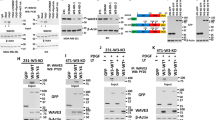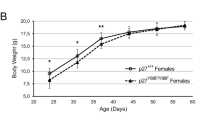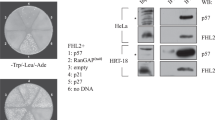Abstract
The activity of the cyclin-dependent kinases (CDKs) that control cell growth and division can be negatively regulated by tyrosine phosphorylation or by the binding of various CDK inhibitors1. Whereas regulation by tyrosine phosphorylation is well documented in CDKs that function during mitosis, little is known about its role in the regulation of CDKs that act in the G1 phase of the cell cycle2. In contrast, much evidence has accumulated on the regulation of G1 CDKs by CDK inhibitors1. The cytokine TGF-β inhibits growth by causing cell-cycle arrest as a result of increasing the concentration of the Cdk4/6 inhibitor p15INK4B/MTS2 (refs 3, 4). Here we report that TGF-β can also cause the inhibition of Cdk4 and Cdk6 by increasing their level of tyrosine phosphorylation. Tyrosine phosphorylation and inactivation of Cdk4/6 in a human mammary epithelial cell line are shown to result from the ability of TGF-β to repress expression of the CDK tyrosine phosphatase Cdc25A. Repression of Cdc25A and induction of p15 are independent effects mediating the inhibition of Cdk4/6 by TFG-β.
This is a preview of subscription content, access via your institution
Access options
Subscribe to this journal
Receive 51 print issues and online access
$199.00 per year
only $3.90 per issue
Buy this article
- Purchase on Springer Link
- Instant access to full article PDF
Prices may be subject to local taxes which are calculated during checkout
Similar content being viewed by others
References
Sherr, C. J. & Roberts, J. M. Inhibitors of mammalian G1 cyclin-dependent kinases. Genes Dev. 9, 1149–1163 (1995).
Morgan, D. O. Principles of CDK regulation. Nature 374, 131–134 (1995).
Hannon, G. J. & Beach, D. p15INK4B is a potential effector of TGFβ-induced cell-cycle arrest. Nature 371, 257–261 (1994).
Reynisdóttir, I., Polyak, K., Iavarone, A. & Massagué, J. Kip/Cip and Ink4 Cdk inhibitors cooperate to induce cell cycle arrest in response to TGF-β. Genes Dev. 9, 1831–1845 (1995).
Reynisdóttir, I. & Massagué, J. The subcellular locations of p15Ink4b and p27Kip1 coordinate their inhibitory interactions with cdk4 and cdk2. Genes Dev. 11, 492–503 (1997).
Kamb, A. et al. A cell cycle regulator potentially involved in genesis of many tumor types. Science 264, 436–440 (1994).
Nobori, T. et al. Deletions of the cyclin-dependent kinase-4 inhibitor gene in multiple human cancers. Nature 368, 753–756 (1994).
Soule, H. D. et al. Isolation and characterization of a spontaneously immortalized human breast epithelial cell line, MCF-10. Cancer Res. 50, 6075–6086 (1990).
Matsushime, H. et al. D-type cyclin-dependent kinase activity in mammalian cells. Mol. Cell. Biol. 14, 2066–2076 (1994).
Meyerson, M. & Harlow, E. Identification of G1 kinase activity for cdk6, a novel cyclin D partner. Mol. Cell. Biol. 14, 2077–2086 (1994).
Schulze, A. et al. Cell cycle regulation of the cyclin A gene promoter is mediated by a variant E2F site. Proc. Natl Acad. Sci. USA 92, 11264–11268 (1995).
Fisher, R. P. & Morgan, D. O. A novel cyclin associates with MO15/CDK7 to form the CDK-activating kinase. Cell 78, 713–724 (1994).
Hoffmann, I., Draetta, G. & Karsenti, E. Activation of the phosphatase activity of human cdc25A by a cdk2-cyclin E dependent phosphorylation at the G1/S transition. EMBO J. 13, 4302–4310 (1994).
Jinno, S. et al. Cdc25A is a novel phosphatase functioning early in the cell cycle. EMBO J. 13, 1549–1556 (1994).
Terada, Y., Tatsuka, M., Jinno, S. & Okayama, H. Requirement for tyrosine phosphorylation of Cdk4 in G1 arrest induced by ultraviolet irradiation. Nature 376, 358–362 (1995).
Meyerson, M. et al. A family of human cdc2-related protein kinases. EMBO J. 11, 2909–2917 (1992).
Pietenpol, J. A. et al. TGF-β1 Inhibition of c-myc transcription and growth in keratinocytes is abrogated by viral transforming protein with pRB binding domeins. Cell 61, 777–785 (1990).
Galaktionov, K., Chen, X. & Beach, D. Cdc25 cell-cycle phosphatase as a target of c-Myc. Nature 382, 511–517 (1996).
Ewen, M. E., Sluss, H. K., Whitehouse, L. L. & Livingston, D. M. TGF-β inhibition of Cdk4 synthesis is linked to cell cycle arrest. Cell 74, 1009–1020 (1993).
Polyak, K. et al. p27Kip1, a cyclin-Cdk inhibitor, links transforming growth factor-β and contact inhibition to cell cycle arrest. Genes Dev. 8, 9–22 (1994).
Polyak, K. et al. Cloning of p27Kipl a cyclin-cdk inhibitor and a potential mediator of extracellular antimitogenic signals. Cell 78, 59–66 (1994).
Galaktionov, K. et al. CDC25 phosphatases as potential human oncogenes. Science 269, 1575–1577 (1995).
Markowitz, S. et al. Inactivation of the type II TGFβ receptor in colon cancer cells with microsatellite instability. Science 268, 1336–1338 (1995).
Eppert, K. et al. MADR2 maps to 18q21 and encodes a TGFβ-regulated MAD-related protein that is functionally mutated in colorectal carcinoma. Cell 86, 543–552 (1996).
Hahn, S. A. et al. DPC4, a candidate tumor suppressor gene at human chromosome 18q21.1. Science 271, 350–353 (1996).
Giaretti, W. & Nusse, M. Light scatter of isolated cell nuclei as a parameter discriminating the cell-cycle subcompartments. Meth. Cell Biol. 41, 389–400 (1994).
van den Heuvel, S. & Harlow, E. Distinct role for cyclin-dependent kinases in cell cycle control. Science 262, 2050–2054 (1993).
Boukamp, P. et al. Normal keratinization in a spontaneously immortalized aneuploid human keratinocyte cell line. J. Cell Biol. 106, 761–771 (1988).
Galaktionov, K. & Beach, D. Specific activation of cdc25 tyrosine phosphatases by B-type cyclins: evidence for mutliple roles of mitotic cyclins. Cell 67, 1181–1194 (1991).
Lukas, J., Bartokova, J., Rohde, M., Strauss, M. & Bartek, J. Cyclin D1 is dispensable for G1 control in retinoblastoma gene-deficient cells independently of cdk4 activity. Mol. Cell. Biol. 15, 2600–2611 (1995).
Author information
Authors and Affiliations
Rights and permissions
About this article
Cite this article
lavarone, A., Massagué, J. Repression of the CDK activator Cdc25A and cell-cycle arrest by cytokine TGF-β in cells lacking the CDK inhibitor p15. Nature 387, 417–422 (1997). https://doi.org/10.1038/387417a0
Received:
Accepted:
Issue Date:
DOI: https://doi.org/10.1038/387417a0
This article is cited by
-
TGF-β in correlation with tumor progression, immunosuppression and targeted therapy in colorectal cancer
Medical Oncology (2023)
-
c-Myc shuttled by tumour-derived extracellular vesicles promotes lung bronchial cell proliferation through miR-19b and miR-92a
Cell Death & Disease (2019)
-
RETRACTED ARTICLE: Linc00152 promotes malignant progression of glioma stem cells by regulating miR-103a-3p/FEZF1/CDC25A pathway
Molecular Cancer (2017)
-
PKM2 dephosphorylation by Cdc25A promotes the Warburg effect and tumorigenesis
Nature Communications (2016)
-
Prostaglandin E2 increases proximal tubule fluid reabsorption, and modulates cultured proximal tubule cell responses via EP1 and EP4 receptors
Laboratory Investigation (2015)
Comments
By submitting a comment you agree to abide by our Terms and Community Guidelines. If you find something abusive or that does not comply with our terms or guidelines please flag it as inappropriate.



